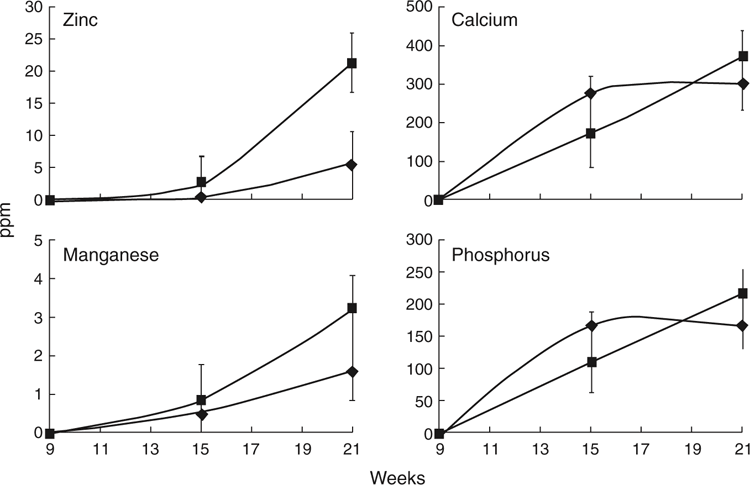Use of trace mineral analysis to quantify the efficacy of mineral supplementation
T. L. Muller A B , R. J. E. Hewitt A and R. J. van Barneveld AA SunPork Farms, Loganholme, QLD 4129.
B Corresponding author. Email: tracy.muller@sunporkfarms.com.au
Animal Production Science 55(12) 1547-1547 https://doi.org/10.1071/ANv55n12Ab108
Published: 11 November 2015
Trace minerals, in particular those that are complexed to organic molecules, have been associated with decreased foot lesions and lameness (Anil et al. 2010a) and have led to increased numbers of pigs born alive and litter birth weights (Anil et al. 2010b). However, the exact mechanism(s) by which these actions occur is not fully understood. This experiment aimed to assess if trace mineral analysis, via hair, could be used to detect increased uptake of amino-acid-complexed (AAC) mineral supplementation above standard inorganic mineral inclusions, with the hypothesis that AAC minerals will not differ in their deposition.
Twenty mixed-parity sows (Landrace × Large White) housed in free-access stalls were allotted to a control (n = 10) or a treatment group (n = 10) based on parity and size. The control group was fed a diet with an inorganic mineral and vitamin premix incorporated into a standard diet [12.9 MJ digestible energy (DE)/kg, 0.40 g standardised ileal digestible lysine/MJ DE]. The treatment group was fed the same base mineral and vitamin premix formulation but with the addition of AAC minerals (Availa®; Zinpro Corp., Eden Prairie, USA), these being Cu (10 ppm), Zn (50 ppm), Mn (20 ppm) and Se (0.15 ppm). Diets were offered to individual sows at 2.5 kg/d, with sows held in stalls during feeding. Five accessible areas on the sow were shaved at the commencement of the experiment: neck, left and right shoulder, and left and right rump. Hair samples were taken from each individual site at 9, 15 and 21 weeks at a time when hair growth was sufficient for collection after diets were first offered. Data were statistically analysed with the individual sow as the experimental unit using GLM (Genstat, 15th Edition; UK).
Results indicated that trace mineral analysis of hair samples might be used to demonstrate differences in dietary mineral uptake (Fig. 1). The analysis of hair samples showed distinctively different patterns of deposition for Zn and Mn depending on the source of these minerals in the diet, whilst the patterns of deposition for Cu and Se were more uniform (not shown). Interestingly, the inclusion of AAC minerals impacted other minerals important for bone health, with the pattern of deposition of calcium and phosphorus being markedly altered (Fig. 1). These results indicated that the impact of AAC minerals is beyond their direct inclusion as a trace mineral supplement and may affect the deposition of important bone minerals, that warrants further investigation to understand this mechanism.

|
References
Anil SS, Deen J, Anil L, Baidoo SK, Wilson ME, Ward TL (2010a) Journal of Animal Science 88, 127Anil SS, Deen J, Anil L, Baidoo SK, Wilson ME, Rapp C, Ward TL (2010b) Proceedings of the 21st IPVS Congress, 1168, eds S D’Allaire and R Friendship.
Supported by Pork CRC Limited Australia.


